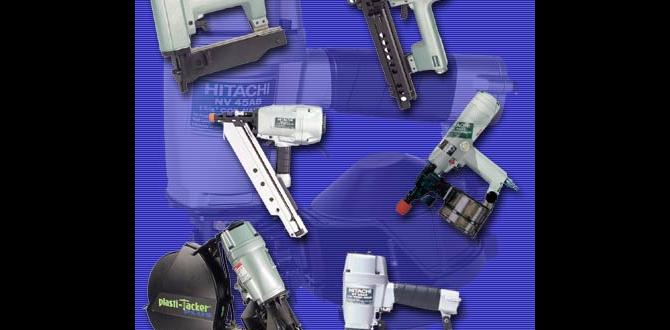Quick Summary: Winterizing your air compressor protects it from cold, moisture, and damage, ensuring it runs reliably when you need it. Simple steps like draining water, securing the unit, and storing it properly prevent costly repairs and keep your tools ready for work.
Hey there, fellow DIYers and woodworking enthusiasts! Jack Shaffer here, your go-to guy for all things nailers and tools.
Got an air compressor that’s lived through its fair share of sawdust and project deadlines? Great! Now, as the temperatures start to dip, it’s time to show that trusty machine some love. Ignoring your air compressor during colder months can lead to some frustrating problems, like frozen pipes or even internal damage. But don’t you worry! This guide is going to walk you through exactly how to winterize your air compressor, step-by-step. We’ll make sure it’s snug, safe, and ready to power your projects all winter long. Let’s get these essential tips rolling!
Table of Contents
Why You Need to Winterize Your Air Compressor
Think of winterizing your air compressor like packing an extra jacket for yourself when it gets chilly. It’s all about protecting your valuable tool from the harsh realities of colder weather. The biggest culprits? Moisture and extreme cold. When water gets into your compressor and freezes, it can expand and crack tanks, pipes, or internal components. Not only is this a costly fix, but it can also leave you high and dry when you most need your compressor for that indoor project.
Beyond just physical damage, moisture can lead to rust and corrosion inside your compressor, reducing its efficiency and lifespan. By taking a few proactive steps now, you’re saving yourself potential headaches and expensive repairs down the road. It’s a small amount of effort for a big return, ensuring your air compressor remains the reliable workhorse you depend on.
Understanding the Risks of Cold Weather for Air Compressors
Air compressors are generally tough, but they aren’t immune to the ill effects of winter. Here’s a breakdown of what can go wrong if you don’t properly prepare them:
- Freezing Temperatures: Simply put, water freezes. Any water remaining in the tank, lines, or pump can turn to ice. As ice expands, it exerts immense pressure. This can lead to:
- Cracked or burst air tanks.
- Damaged regulators and hoses.
- Compromised seals and gaskets.
- Condensation Buildup: Even in cooler temperatures, air contains moisture. As your compressor runs and cools down, this moisture condenses into water. In winter, this water can freeze within the system.
- Lubricant Issues: While less common with modern compressors, some older oil-lubricated models might have lubricants that can thicken in extreme cold, making startup sluggish or even causing issues if the oil doesn’t flow properly.
- Reduced Performance: Extreme cold air is denser. While this might seem like a positive, it can sometimes put extra strain on the motor and pump if not designed for it, potentially affecting efficiency.
The good news is that these risks are entirely preventable with a little preparation. Let’s dive into how to get your compressor ready.
Step-by-Step Guide: How to Winterize Your Air Compressor
Following these steps will ensure your air compressor stays in top condition throughout the winter. It’s simpler than you might think!
Step 1: Safely Disconnect and Drain the Compressor
This is the absolute most crucial step. We need to get rid of any moisture that could freeze.
What you’ll need:
- Safety glasses (always!)
- Gloves
- A drain pan or bucket
- A rag
Here’s how:
- Power Down: First things first, unplug your air compressor from the power source. You don’t want a surprise startup!
- Release Pressure: Slowly open the drain valve at the bottom of the air receiver tank. If you have a regulator on your setup, you can also open that to help bleed off any residual pressure. Let all the air out until the tank is completely depressurized.
- Drain the Water: Position your drain pan or bucket directly underneath the drain valve. Carefully open the valve. You’ll likely see water – and possibly some oil if it’s an oil-lubricated model – drain out. It might be murky; that’s normal. Let it drain completely.
- Open and Close Valve (Optional but Recommended): For some models, it’s a good idea to open the drain valve slightly after draining and then close it securely. This ensures it’s not stuck open or closed, and you can confirm it operates smoothly.
- Inspect the Valve: Give the drain valve a quick wipe with a rag. Make sure there’s no obvious damage or gunk preventing it from sealing properly.
Getting all that water out is your main defense against freeze damage. Don’t rush this part!
Step 2: Clean the Exterior and Components
A clean compressor runs better and is easier to inspect. Winter is a great time to get it looking sharp and ready for storage or continued use.
What you’ll need:
- A soft brush or vacuum cleaner with a brush attachment
- A clean, lint-free cloth
- Mild degreaser or appropriate cleaner (check your manual)
- Compressed air (optional, for blowing out dust)
Here’s how:
- Dust Off: Use your soft brush or vacuum attachment to remove any loose dust, dirt, or debris from the exterior casing, motor vents, and pump area. Pay special attention to intake filters.
- Wipe Down: Dampen a lint-free cloth (don’t soak it!) with a mild cleaner or degreaser suitable for your compressor’s materials. Wipe down the entire exterior.
- Address Stubborn Grime: For tougher spots, you might need a bit more cleaning power. Again, check your owner’s manual for recommended cleaning agents to avoid damaging plastics or finishes.
- Clean Intake Filter: The air intake filter is vital for preventing dust and debris from entering the pump. If it’s a washable filter, clean it according to the manufacturer’s instructions. If it’s a paper element, inspect it for damage and replace it if necessary. A clean filter means your compressor breathes easier.
- Air Blow-Out (Optional): If you have access to a small amount of compressed air, you can gently blow out any dust from hard-to-reach nooks and crannies, especially around the motor and pump.
A clean compressor not only looks good but also allows you to spot any potential issues like leaks or wear more easily.
Step 3: Inspect for Damage and Wear
While you’re cleaning, take a moment to be a detective. Look for anything that seems out of place.
What to look for:
- Cracks or Dents: Check the tank, housing, and any external pipes for any signs of physical damage.
- Loose Bolts/Connections: Gently wiggle connections and check if any bolts feel loose. Tighten them up if necessary.
- Hose Condition: Inspect your air hoses for cracks, bulges, or leaks. A damaged hose is a safety hazard and an efficiency killer.
- Gauge and Valve Function: Ensure pressure gauges are clear and seem to be working. Operability of drain valves and safety release levers should be confirmed.
If you spot any significant damage, it might be time to consult your manual or a professional for repairs before storing or using it in cold weather.
Step 4: Lubrication (If Applicable)
For oil-lubricated compressors, ensuring the oil is clean and at the correct level is important, especially if you plan on using it in unheated spaces. For oil-free compressors, this step isn’t necessary as they don’t use engine oil.
For Oil-Lubricated Compressors:
- Check Oil Level: Locate the oil sight glass. If the oil level is low, top it up with the manufacturer-recommended type and weight of oil.
- Change Oil (If Dirty/Old): If the oil appears discolored, sludgy, or it’s been a long time since it was changed, now’s a good time for an oil change. This helps prevent internal corrosion and ensures proper lubrication. Drain the old oil when the compressor is warm (but unplugged and depressurized!), then refill with fresh oil.
Refer to your air compressor’s manual for specific instructions on checking and changing oil. Using the correct oil is vital for the longevity of the pump.
Step 5: Consider Where You’ll Store or Use It
The environment where your compressor spends the winter matters!
Indoor Storage:
- Avoid Damp Areas: Don’t store it directly on a cold, concrete floor where condensation is common. Place a piece of wood or a mat underneath.
- Stable Surface: Ensure the storage area is level and dry.
- Temperature: While it doesn’t need to be heated, avoid extreme fluctuations if possible.
Outdoor Storage (Use with Caution):
- Protection is Key: If it must be stored outdoors, it absolutely needs protection from the elements. A breathable tarp or a dedicated outdoor equipment cover is essential. Avoid plastic sheeting that can trap moisture.
- Elevated: Keep it off the ground to prevent moisture wicking and potential freezing from ground contact.
- Consider a Shed: An unheated shed or garage is a much better option than direct exposure.
For compressors that will see intermittent use throughout the winter, ensuring they are in a relatively stable, dry environment is key.
Step 6: Secure Hoses and Accessories
Keep everything tidy and protected.
Here’s how:
- Coil Hoses: Neatly coil air hoses. Avoid kinking them severely. Keeping them off the ground protects them from dirt and potential damage.
- Store Attachments: If you have pneumatic tools or accessories, clean them and store them in a designated toolbox or storage bin. For tools you won’t be using, it’s good practice to disconnect them.
- Manage Cords: Wrap power cords neatly and secure them so they don’t become a tripping hazard or get damaged.
Organization makes it easier to find what you need and protects your gear.
Step 7: Final Checks Before Storing or Using
A quick once-over can catch last-minute issues.
What to do:
- Visual Inspection: Give it one last look. Does everything seem secure? Is the drain valve closed tightly?
- Filter Check: Ensure the intake filter is clean and properly seated.
- Cord Condition: Double-check the power cord for any fraying or damage.
If storing long-term, consider running the compressor for a few minutes periodically (if safe to do so) to keep seals from drying out, though draining and proper storage usually suffice.
Storing Your Air Compressor Long-Term for Winter
If you’re not planning on using your air compressor much over the winter months, a more thorough storage preparation might be in order. The goal is to leave it in a state where it’s protected from corrosion and moisture.
1. Thorough Cleaning and Inspection
As detailed in the steps above, ensure it’s spotless. This is also the time to proactively address any minor issues you might have noticed throughout the year. A little repair now can prevent a big problem later.
2. Lubricate Moving Parts
For oil-lubricated models, changing the oil to fresh, clean oil is highly recommended for long-term storage. This helps prevent internal corrosion caused by contaminants or moisture that might have been in the old oil. Follow your manufacturer’s guide precisely for the type and amount of oil to use.
3. Protect Against Rust
While draining the tank is primary, some folks like to add a rust inhibitor into the tank after it’s fully drained and dry. A light spray of a silicone-based lubricant or a dedicated rust-inhibiting spray inside the tank (ensure it’s safe for air compressors and your particular model!) can provide an extra layer of protection against internal rust. Be sure to thoroughly purge this out when you next use the compressor. Alternatively, lightly oiling the cylinder walls of the pump (if accessible and recommended by the manufacturer) can also help.
4. Seal Connections
Ensure all valves and connections are securely closed to prevent any air or moisture ingress. Some suggest covering exhaust ports or intake areas with a breathable cloth or plastic bag secured with a rubber band, especially if storing in a dusty or damp environment.
5. Choose an Ideal Storage Location
The best place for long-term storage is a cool, dry, and stable environment. An insulated garage, a basement, or a dedicated storage shed are ideal. Avoid areas with extreme temperature fluctuations, high humidity, or direct exposure to the elements. Storing on a pallet or a wooden platform can help keep it off a cold, damp concrete floor.
6. Cover Appropriately
Once stored, cover the compressor. A breathable fabric cover is better than a sealed plastic one, as it allows any residual moisture to escape. If you must use a plastic cover, ensure it doesn’t trap moisture against the compressor. Some folks use large plastic bags secured loosely, taped only at the bottom to allow some airflow but prevent dust and pests.
Tips for Using Your Air Compressor in Cold Weather
If your projects don’t stop just because it’s cold, and you need to use your air compressor, here are some tips to keep it running smoothly:
1. Pre-Start Warm-Up (If Possible)
If your compressor has been stored in a very cold environment, try to move it to a slightly warmer location (like a garage or workshop) for an hour or two before starting it up. This helps ensure any residual moisture is less likely to freeze and allows lubricants to flow more freely.
2. Listen and Observe
When you first start the compressor, pay attention to any unusual noises, vibrations, or sluggishness. If anything seems off, shut it down immediately and inspect it. Remember, even after winterizing, rapid temperature drops can still cause issues.
3. Drain Frequently
Even if you winterized it, condensation can still form as you use it. Make it a habit to drain the tank at the end of each work session, or even during longer sessions if you’re running it in very cold or humid conditions. A quick drain can prevent water from freezing.
4. Keep Hoses Clear
Ensure your air hoses aren’t lying in puddles of water or snow, as they can still freeze up and become brittle or blocked. Coil them up and keep them as dry as possible.
5. Check Filters
Cold air is denser, meaning more moisture can be carried into the compressor. Keep an eye on your air intake filter; it may get saturated faster. A wet filter can be problematic, so dry or replace it as needed.
Essential Tools and Materials for Winterizing
You don’t need a workshop full of specialized equipment to winterize your compressor. Here’s a simple list:
Tools:
- Safety Glasses
- Work Gloves
- Rags (lint-free are best)
- Drain Pan or Bucket
- Soft Brush or Vacuum Cleaner with Brush Attachment
Materials:
- Manufacturer-Recommended Lubricating Oil (for oil-lubricated models)
- Mild Cleaner or Degreaser (check manual)
- Optional: Rust Inhibitor Spray (ensure it’s air compressor safe)
- Optional: Breathable Tarp or Cover
Always refer to your specific air compressor’s owner’s manual for any unique recommendations or types of lubricants/cleaners to use.
Troubleshooting Common Winterizing Issues
Even with the best intentions, you might run into a snag. Here are a few common issues and how to tackle them:
| Problem | Possible Cause | Solution |
|---|---|---|
| Drain valve is stuck. | Corrosion, dirt, or debris. | Try tapping it gently. Apply a penetrating lubricant around the valve stem (ensure it’s safe for your compressor). With safety glasses on, try to carefully work it back and forth. If it still won’t budge, consult your manual or a professional. |



